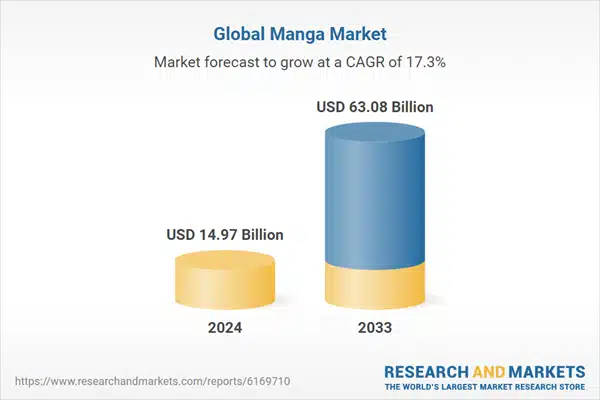The international manga market is expected to grow to $63.08 billion by 2033, up from $14.97 billion in 2024, at least according to a report from ResearchAndMarkets.com.
Reports such as these are a small business in themselves – to read the whole thing will set you back $2,490 – but it’s a nice number to quote at the next cookout.
The report, “Manga Market by Type, Genre, Audience, Gender, Distribution Channel, Countries and Companies Analysis 2025-2033”, says that manga is growing due to
increasing international demand, widening digital platforms, and heightened anime adaptations driving global readership. Manga’s cross-cultural attractiveness remains to draw different age groups, boosting its market potential worldwide.
While the number seems a bit optimistic – will we even be able to READ in 10 years? – there’s no question but that manga and anime have taken the world by storm.
1. “30% of global consumers watch anime at least weekly, making anime now mainstream. However, it’s 50% of Millennials and Gen Z!
2. Anime titles are increasingly available on global streaming platforms like Netflix, Disney+, and PrimeVideo.
3. Fans are willing to splurge on merchandise featuring it
4. We are now seeing anime IP being leveraged in apparel (Uniqlo, Old Navy, among others), quick service restaurants (McDonald’s), and luxury (Loewe).
5. The Dentsu research shows that 3 in 10 anime viewers globally have spent more than $200 USD last year on IP-inspired merchandise, a share that grows to 40% in the case of U.S. respondents.”
But you don’t have to read fancy reports to see why this is The Year of Anime.
Demon Slayer: Kimetsu no Yaiba Infinity Castle has been the top grossing movie in the US for two weeks running. That’s unheard of. Its the biggest grossing anime ever in the US, surpassing the previous top anime, Pokemon The First Movie in 1999. With a worldwide box office of $555 million worldwide, it’s the highest-grossing anime and Japanese film ever globally.As many have pointed out, that’s more the Fantastic Four made globally. Move over, Thing.
While Sony may have messed up by passing Kpop Demon Hunters to Netflix, they guessed right with Infinity Train, The Hollywood Reporter reports:
For longtime followers of anime’s rise, the scale of Demon Slayer’s latest success with Infinity Castle is the culmination of trends that have been slowly building for decades. What was once niche otaku culture has become a mainstream global force, embraced by Gen Z and Gen Alpha but increasingly multigenerational, multiracial and borderless in its appeal. Sony, perhaps not surprisingly, recognized this potential sooner than most. Since acquiring anime specialty service Crunchyroll from AT&T in 2020 for $1.18 billion — and merging it with its earlier anime platform buy, Funimation — the Japanese conglomerate has steadily transformed anime from a promising vertical into a core strategic pillar. Today, Crunchyroll spans far more than a subscription platform: It’s also North America’s leading distributor of anime films, a global licensing and merchandising operation, an anime fandom events business, and an emerging hub for music and games. At CES earlier this year, Sony executives described anime as one of the group’s central growth bets, with the sector forecast to become a $60 billion global industry by 2030.
There’s lots more from Crunchyroll head Rahul Purini in the above, including why anime is such a huge part of youth culture:
In terms of your first question, it’s absolutely true. Gen Z and Gen Alpha are a huge part of this fandom. But that doesn’t mean they’re the only age groups. We saw a lot of parents coming to see Infinity Castle with their kids, and there were many fans in their 30s, 40s and 50s. Anime fandom does overindex among the young, though.
We’ve been cultivating these relationships with young adults for a long time. So, it’s all of the things you would imagine — TikTok, Reddit AMAs and Discord; hosting real-world events for young fans and influencers to attend; and engaging the celebrity anime fans that young people follow and listen to. It’s also about being very present on YouTube, Roblox and Fortnite, and in the various other places where this young audience spends time and participates.
It cuts across various genres and subjects of interest to children, young people, and both male and female adults. This flexibility enables it to serve both educational, entertainment, and emotional requirements. Women’s (shojo/josei), children’s (kodomo), and men’s (shonen/seinen) manga have generated enormous sub-markets with devoted readers, which have helped the market expand stoutly. Publishers and creators are aggressively looking for collaborations with anime companies and gaming firms to produce cross-media content that maximizes the exposure of manga. Cross-platform is facilitating revenue across various entertainment streams, reaffirming the interconnectedness of the manga business.
I had my own take on this, but Popverse pulled out another factoid from the Dentsu report: why young readers find manga fresh and accessible:
The data is packed with interesting facts about the growth of anime outside of Japan, but one statistic that might be worth noting for Hollywood is that 11% of those surveyed who watch anime did so because they were “tired of sequels and remakes in Hollywood (like Star Wars, Marvel, DC) and want something new, a number that grows to 29% in the US.
It turns out Volume 1 is always a good jumping on point.
While that $63 billion figure is highly speculative, the core point stands: manga is a huge business globally.













Hi! German manga publisher here. I’m not sure what the projection includes – only manga, or also anime, merchandise, games and other related media…? If only manga, I would have serious doubts.
That is such a highly speculative number. I will be interested to see US Numbers.
Unit Manga sales dropped 26% in 2023, according to Circana BookScan data. Unit sales fell from record-highs in 2022 to 21.8 million in 2023, still far above the 4 million units sold in 2019.
Revenue declined less dramatically with the total retail value of print manga dropping 13% to $381 million in 2023.
In 2024, the Manga numbers were down again from 2023, as the US market remained declining. A 8% decline was reported which is outside the margin of error. This is combined digital and physical number.
The surprising news in 2024 was sales of physical manga volumes in the U.S. decreased in 2024 by 18%, after the 26% decline in 2023.
For the first time since 2020, Western graphic novel unit sales surpassed those of manga. And in a huge manner, 39% higher. The two largest growth numbers were provided by Scholastic and DC Comics.
Some industry analysts describe this as an “inevitable” market correction. As parents are becoming more aware of the content in Manga publications. This leads the dollars to be pulled to the Western graphic novels sector.
In the US, the rise in Digital Dollar Numbers in the Manga market are not off-setting the print decline. Digital-Theft is far greater in the Manga market, then the Western graphic novel market.
Bad joke time: Jonah Hex is damn popular and must be in the home of nearly every American.
I am always amused with the term “Western graphic novel market”. Wouldn’t “Traditional US Graphic Novel market”, work better??
Pfft, projections over a longer period rarely pan out. Remember 2019’s pre-Covid idea’s about what 2027 would look like? Though Disney had already released the much (and justly) maligned Last Jedi, which destroyed a lot of ‘Star Wars Goodwill’ among fans, the Marvel Cinematic Universe seemed unassailable and Disney appeared to be king of the entertainment industry. Enter a slew of mediocre and ill-considered releases, and now online know-it-all’s consider them out for the count.
Bear in mind that manga itself has been struggling for decades because of Japan’s diminishing population. It has in fact become a tourist industry. As soon as this happens, innovation stagnates, and overexposure of familiar IP will prevail. Audiences will drop out because of fatigue (a common complaint about manga’s is that series tend to drag on for too long when proven popular.)
Sounds familiar? Can’t wait for ‘One Piece First Paddle’ to be a Box Office disappointment in 2033….
Comments are closed.